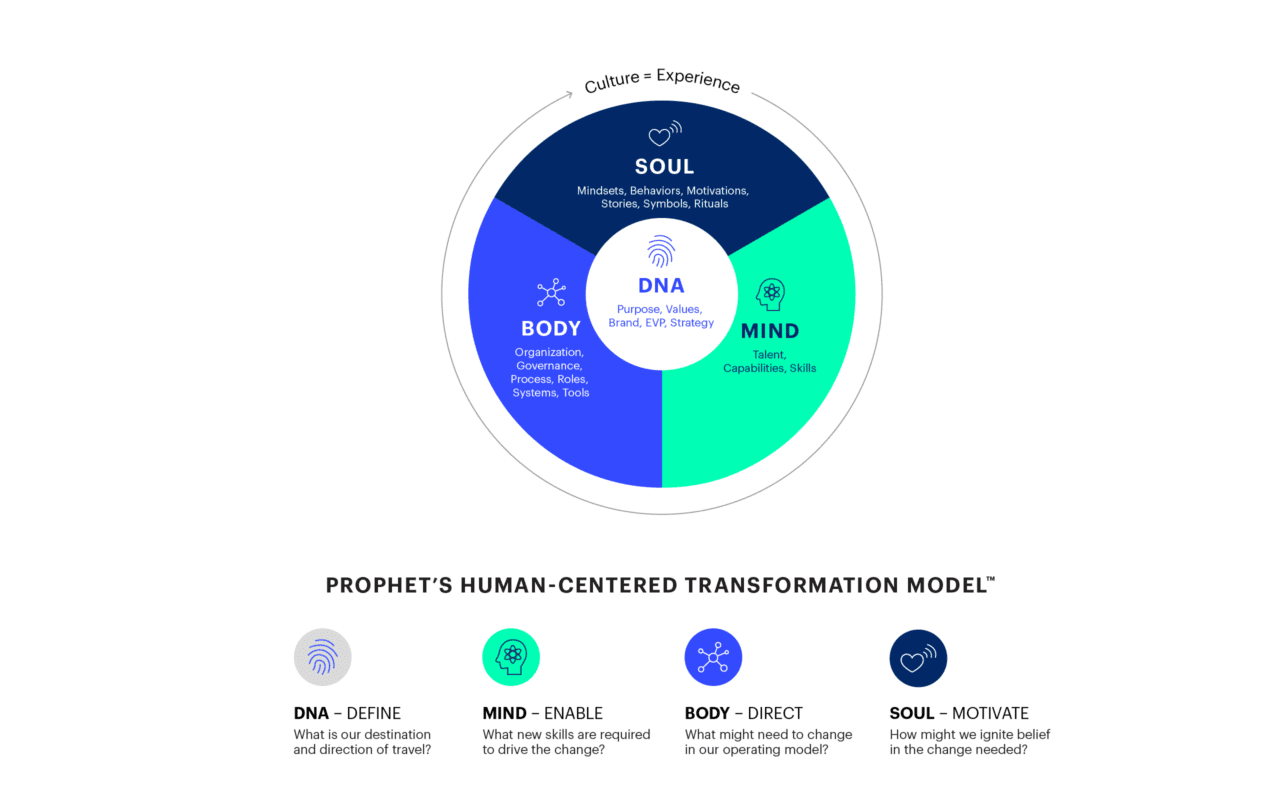BLOG
3 Steps to Human-Centred Leadership in a Hybrid Working World
A co-created philosophy, agility and aligned leadership can smooth the way for hybrid work models.
Everywhere you look organizations are trying to figure out how to future-proof themselves. Organizations are grappling with how their flexible, hybrid working model might look and how to cope with the diversity of employee preferences created by the pandemic.
The role of leadership has never been more important to the health of employees and the success of the organization as business leaders across the globe manage through this uncertainty. What was considered effective leadership pre-pandemic (coaching, feedback, empathy, trust) is now a basic leadership requirement. And as the war for talent intensifies, the quality and empathy of leadership will be an important differentiator for current and prospective employees.
“As the war for talent intensifies, the quality and empathy of leadership will be an important differentiator for current and prospective employees.”
Therein lies the problem. The general quality of leadership is not where it needs to be. In 2020, MIT global research with c5000 Executives found that less than 10% of employees strongly believed that their organizations had leaders with the right skills to thrive in the digital economy. But the pandemic turned every leader’s world fully digital overnight.
At Prophet, we have developed a Human-Centred Transformation Model™ that guides holistic cultural change and identifies organizations as macrocosms of an individual with DNA (strategy, values, purpose, Mind (talent, skills, capabilities), Body (structures, processes, tools) and Soul (mindsets, behaviors, rituals). Through the lens of the model and our client work, we have identified three steps that will help you raise the floor of your leadership capability and take a human-centered leadership approach in a hybrid and digital world.

Step 1: Co-create a leadership philosophy (DNA)
Leadership is a term that everyone understands or thinks they do. We all have our own view of what a strong leader looks like and who we want to emulate. However, individual perspectives don’t breed quality or consistency. It’s critical for your leadership (and your employees) to co-create and align on the version of leadership that’s right for your strategy, your people and your culture, particularly in your new hybrid context.
In addition, the remit of leadership has changed. With societal trends coming to the forefront of daily organizational life, leaders can’t lead without acknowledging and supporting their people during uncertain times. Leading with values and purpose is a prerequisite now; leaders cannot focus solely on strategic or operational topics to get them through.
Allied to that point, leadership roles should include a tangible set of leadership responsibilities and objectives. For example, leaders need to be leading, not just doing tasks or making decisions. They must be empowering, nurturing and guiding their teams. It takes time, effort and skill to adopt a human-centered approach to leadership and to do it well. Ensuring your leaders adopt the mindset that human-centered leadership is critical to the organization’s performance, will provide a strong platform to develop your leadership capabilities.
Step 2: Build agility into your leadership development framework to align with your culture and strategic priorities (MIND)
Traditionally, many organizations use prescriptive models of what good leadership looks like, developed directly from theory. However, they were never especially applicable in your organizational context and – rigid by design – they are now out of touch with what’s required in an ever-changing, hybrid world.
The shift to hybrid working provides a reset opportunity and there are some improvements that will help you make your leadership development investment more impactful going forward:
- Revisit your leadership development approach regularly – now that we are in a hybrid world, tailor your approach to your new context and your strategic priorities. Measure progress and adopt an agile approach that keeps it simple and focuses on only a few priority areas at a time
- Over-index on purpose, values and the human, empathetic elements of leadership – your employees need more meaningful communication and an increase in the level of emotional and personal support in a hybrid environment
- Prioritize collaboration and compromise as central tenets of your leadership framework – the days of heroic individual leaders are long gone. Leadership needs to come together and zero in on what’s best for the organization and the people, rather than protecting their specific domain
- Bring new capabilities to life on the job – set expectations and challenges, create a safe environment to experiment with new leadership ways outside of the development space
A refocus away from the traditional approaches will increase your chances of moving the needle on leadership significantly. In parallel, it’s important to make leadership development accessible to more than just an elite, senior group – take a youth development policy in order to build leadership as a strategic advantage over time.
Step 3: Create an aligned leadership ecosystem (BODY & SOUL)
One of the biggest complaints Harvard Business Review hears about executive education is that the skills and capabilities developed don’t get applied on the job. A note of warning: your leadership ecosystem will make or break your effort. This is the area that most organizations don’t realize they need to address. The most important step you can take to support consistent and effective leadership in action is to analyze how your culture and operating model are impacting your leadership practices and behaviors. Then you can align the critical levers to incentivize, rather than deter, the desired approach.
Additionally, all the development activities in the world won’t create the leadership you want ‘on the job’ unless your organizational ecosystem supports and rewards the desired leadership approach. The latest global research from Prophet’s Organization and Culture practice identified the fundamentals and accelerators for cultural change (e.g., ambition, roadmap, role modeling, decision making, incentives and rewards, mechanisms to experiment) and it’s important to address these to create the environment and the enablers that will embed the new leadership behaviors.
Releasing leaders from a development environment back into their day jobs without adaptive mechanisms and expecting them to change their behavior when all the rituals, processes and incentives encourage them to lead in the same way they always have done is a mistake. This instantly erodes all the value and effort of your investment in leadership development activity. Sadly, this is still all too common in organizations today.
FINAL THOUGHTS
To summarize, tailoring your approach and aligning across these three dimensions will help you strengthen leadership and equip your organization to navigate through the unchartered waters ahead. The hybrid workplace is different and it demands leadership that is genuine, empathetic and cognizant of the world we live in; we call it human-centered leadership.
If you need help adapting leadership behaviors to excel in the new hybrid working world then reach out today.
